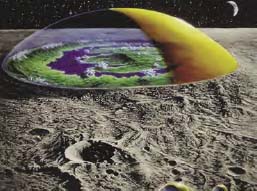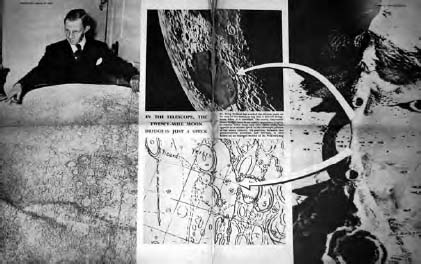Read Ancient Aliens on the Moon Online
Authors: Mike Bara
Ancient Aliens on the Moon (15 page)
AS14-66-9301 The “Mitchell Under Glass” image from the Ken Johnston Collection.

Apollo 12 image showing astronaut Alan Bean in front of glass like lunar structures beyond the horizon.

Self portrait of astronaut Alan Bean.

Imagined lunar dome as it might have appeared eons ago.
MARE CRISIUM
It is very strange the way the ejecta from Proclus
crosses Crisium. It is almost like flying above a haze
layer and looking down through the haze.
It looks like it is suspended
over
it.
– Al Worden,
Apollo 15 Command Module Pilot
M
are Crisium (the “Sea of Crises”) is dark colored, 350 mile wide “pond-effect” impact basin in the northern hemisphere of the Moon, just northeast of the Sea of Tranquility. Centered roughly 20° north and 60° east, it is near the eastern edge of the face of the Moon visible from Earth. It has relatively few major features, of which the major craters Proclus, Picard, Pierce and Cleomedes are the most prominent. The entire Crisium basin covers an area of about 65,000 square miles and is the source of one of the gravitational anomalies known as “mascons” (or mass concentrations) that I mentioned in the first chapter. No one knows what causes the mascons, but the most likely scenario is that there is a buried chunk of the asteroid or comet that created the mare basin beneath the surface. It has a geometric appearance, a roughly hexagonal shape, and is the source of a number of enduring mysteries of lunar anomaly investigation.

NASA photo AS15-M-0954.
The standard model for Crisium’s smooth, dark appearance is that sometime after the major bombardment of the Moon which formed most of its plentiful craters, a large object struck the lunar surface with such force that it made the area within the boundaries of Crisium molten. After some period of time, the area cooled and dark “basaltic lavas” (volcanic rocks) gave the region its dark, pond like appearance. Most of the visible craters in Mare Crisium are most probably smaller (and later) impacts that upset the relatively smooth surface of the “pond.” This would seem to be supported at least in part by the presence of the mascon, which as stated above may be the remnants of the impact event which formed the region. None of this however explains how the region ended up shaped like a hexagon. It should have a rounded outline, like all other “normal” impact basins.

Telescopic view of hexagonal Mare Crisium impact basin.
Mare Crisium is also the location of at least 12 Transient Lunar Phenomenon reports over the years. In 1882, an English mechanic who was also an amateur astronomer named J.G. Jackson made the following observation of Crisium:
Last evening (May 19th) on observing the moon’s slender crescent, about two days old, I was struck with a very peculiar appearance on the westerly side of Mare Crisium, just on, or immediately within, the dark of the ‘terminator. ’ It seemed a curved feathery mist or cloud lying just over the edge of the ‘Mare,’ and against the spur or range of mountains bounding the westerly side of the great valley. It seemed to be divided longitudinally by a faint dark line, and looked not unlike a feather. It must have been more than 100 miles long, by 40 or 50 miles wide. The definition was excellent, and I watched it for nearly an hour, showing it to several friends. In colour and appearance it was so strikingly different from the other illuminated parts, and so different from anything else I have ever seen on the moon, that I scarcely think it possible to be mistaken in its vapory character.
1
In 1897, an astronomer named Jasper D. Hardy added to the lore in a report in an issue of the British Astronomical Associations
Journal:
“Now, at various times when studying the floor of Mare Crisium, I have noticed waves of light and shade, so that it was difficult at times to see objects with which I was perfectly familiar. Also clouds have passed over the object I have been viewing. These clouds have been seen by other observers, and are mentioned in Neison. That they belong to the moon there can be no doubt, and I gradually come to the conclusion that vapor of some kind still existed on the moon. I had my surmises verified on one particularly fine night (the best I ever had) when I plainly saw a well-defined cloud pass over the object I was copying.”
2
Another, more anonymous observation was reprinted in the science anthology
W.R. Corliss’s Mysterious Universe; a handbook of astronomical anomalies:
Mr. Robert M. Adams has called to our attention a curious lunar observation by Mr. Robert Miles of Woodland, California, an observation rather reminiscent of Mr. Brian Warner’s article on pages 130-131 of our November-December 1955 issue.
Mr. Miles says in part:
“I noticed
a flash
of white light that caught my eye. At first I thought it could have been a lunar meteor. But it kept flashing on and off… The light was very bright but changed its color to a very bright blue, like an arch light. It was brighter than the sunlit portions that I was looking at.”
Sketches indicate that the object in question lay on the night side of the terminator and perhaps about 100 miles east of the gap in the mountains on the east boundary of the Mare Crisium. Mr. Miles found the duration of visibility of the flashing light to be from 3:00 to 4:30 U.T. on January 17, 1956. The colongitude was then 320°.5 to 321°.3. These colongitudes seem inconsistent with the sketches, and the editor suspects that the U.T. date was really January 16.
3
What each of these observations correlate, both in the transient manner of their observation and in the variance of color is that there seems to be historical evidence supporting the glass scaffolding theory over Mare Crisium. As we discussed in the previous chapter, light reflecting off of panes of glass and passing through multiple layers of glass would of course produce multi-colored specular reflections. Such light phenomena would obviously be transient in nature, ending when the Moon and Earth moved relative to the light source (the Sun). And the hazy, vaporous appearance is consistent with the observations made by Apollo 15 astronaut Al Worden at the beginning of this chapter. As panes of glass are illuminated, shattered remnants of the more beaten down edges of the structures will have a hazy appearance—like frosted glass — causing the illusion of being cloud-like.
But none of these less well known observations had the impact of a much more prominent anomaly in the Crisium region; the so-called “Mare Crisium bridge.”
The first hint of controversy around the bridge was noted on July 30
th
, 1953 when a science writer for the
New York Herald Tribune
, John J. O’Neill, first spotted and reported observation of what he described as a natural “bridge” over two ridges in the Mare Crisium region near the crater Picard. Excited, O’Neill asked several prominent lunar researchers of the day to confirm his discovery.
Fairly quickly, a British astronomer named Dr. H. P. Wilkins did just that. He first reported his findings in a February 13
th
, 1954 issue of the Sunday tabloid
The Illustrated.
4
He also published a more official paper on the bridge in the British Astronomical Association’s
Journal
in February 1954 which included more sketches of his own observations. His characterizations at that time were of basically along two lines. First, he confirmed that he himself had seen what he thought was the same bridge across the two ridges that O’Neill had seen, and second, at least in this context, he asserted his belief that the “bridge” was a natural erosive formation on the Moon. Given that this presentation was in an official scientific journal, his caution is unsurprising.

Coverage of the Mare Crisium “bridge” from
The Illustrated
in 1954.
Later (I’m unable to determine the exact date but it may have been December 23
rd
of 1953 or 1954), Wilkins stated in a BBC radio interview that he had confirmed a man-made (or alien-made, to be more accurate) “bridge” stretching across a significant portion of Mare Crisium. “It looks artificial. It’s almost incredible that such a thing could have been formed in the first instance, or if it was formed, could have lasted during the ages in which the moon has been in existence,” Wilkins was quoted as saying about the 12-mile long structure he sighted.
5
